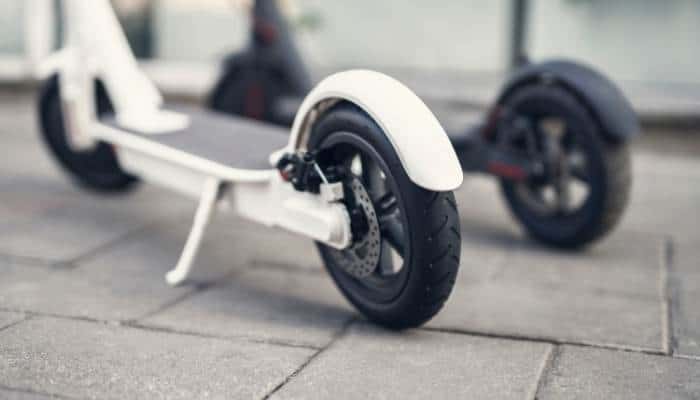Electric scooters are fun, practical and yes, sometimes maddeningly frustrating! Why? Like any electric device or product, they will break down on occasion. This can result from dropping them, riding accidents, lousy riding practices, poor maintenance, mishandling, wear-and-tear or just because the little gremlins who live inside are having a bad day.
When it does happen, it’s good to know that you don’t always have to carry your dead e-scooter to the repair shop and that with some basic electric scooter troubleshooting you can fix the problem yourself. This article will help you identify and fix some of the more common issues to get you going again. Each “fix” is rated ONE wrench to FIVE wrenches from easiest (i.e. no technical knowledge or tools) to some DIY know-how, up to the most difficult (requiring specialised technicians and tools).
How to Fix an Electric Scooter?
Problems with electric scooters come in many forms. Some are quite minor and easy to handle by yourself, while others are more serious and might require a visit to the nearest repair shop since they have experienced technicians and specialised tools. Here are some of the problems you might encounter with your electric scooter:
My Electric Scooter Won’t Start.

Problem: When you press the start button, nothing happens (no indicator lights or sounds).
Possible Cause: It could be a loose or faulty power switch.
Solution: Yes, it’s obvious, but make sure the power switch is in the ‘ON’ position. Otherwise, make sure it clicks or snaps with an audible “click” in both the on and off positions. If it doesn’t or feels loose, then the switch is probably defective and needs replacement.
Some e-scooters need to be moving to start. Stand on the deck, and push while fully engaging the throttle… it should run once you release the throttle.
Malfunctioning key or power switch (tools needed: multi-meter). The key or power switch clicks into place and appears normal, yet the e-scooter does not turn on. In this case, you will need to conduct a “continuity test” on the switch itself using the multimeter.
Why isn’t My Electric Scooter Working?
Problem: After confirming that the battery charger is OK, the e-scooter still won’t run.
Possible Cause: It could be a wiring issue (loose or damaged), or loose solders/welds on the battery. This can be due to excessive speeds or riding over very rough road surfaces.
Solution: To inspect for damaged, loose, or disconnected wiring.
- Remove the deck panel located on the bottom of the e-scooter.
- Check that wires leading from the battery to the controller are connected / intact.
- Press down on the connectors to make sure they click into place.
Broken solders/welds on the battery pack (tools needed: soldering iron). Connectivity between the battery pack and controller occurs at various solder or weld points on the battery. Press down on each point to ensure that it has not broken loose due to excessive vibration during use. If any of the solder points seem loose when you press down, then you will need to re-apply solder to keep it firmly in contact with the battery. Extreme caution needs to be taken when dealing with the heated iron tip near the battery area.
Burned or melted insulation wiring and wire connectors. Use your sense of smell to trace any burned or melted wires on or near the controller. While this is reliable to a point, your speed controller could still be defective even if there are no traces of burned wires. Speed controllers need specialised technicians and special tools to test properly. However, you can determine that it is a problem through the process of elimination (i.e. check battery port, welds, fuses, etc.)
Why is My Electric Scooter Going so Slowly?
Problem: When you try to increase speed, the e-scooter does not speed up at all.
Solution: Inspect the speed controller for overheating as this directly impacts its operating efficiency. Any burned or melted wiring could be a sign of a damaged controller.
Faulty Brake Lever: (Tools needed: 1m electric wire or jumper wire). Since the brake switch’s normal setting is ON for most electric scooters (it turns the motor off when brakes are applied), you need to disconnect the wire from the speed controller and see if the e-scooter runs. If it works then the brake lever switch need replacement.
Some models will have a CLOSED switch by design, in which case you will need to disconnect the brake lever wire connector from the speed controller and “bridge” its brake switch connector terminals together. If the e-scooter runs, then the brake switch (closed type) is faulty.
Electric Scooter Throttle is Not Working.
Problem: The speed display and/or lights aren’t illuminating you twist the throttle.
Solution: Due to the throttle’s complexity, the best solution is to locate the problem through the process of elimination, making sure wires are not loose or damaged.
Visually inspect the wires leading from the throttle to the controller. To inspect the wires, remove the deck panel located on the bottom of the e-scooter. Check that wires leading from the throttle to the controller are connected / intact. Press down on the connectors to make sure they click into place.
The battery might be drained or not charging. See – Electric Scooter is Not Charging
The fuse might have burned out (tools needed: multi-meter). See below – Electric Fuse Location.
Test connectivity of the throttle/controller (tools needed: multi-meter). Verify that the controller supplies sufficient power to the throttle and that the throttle is also sending signals back to the controller. Test the red (+5V wire) and black (ground) wires coming from the controller.
If you get a reading less than 4.3V – 5V output Voltage then it is defective (or it could be any of the other parts connected to it such as the battery pack, power switch, fuse, fuse holder, wires, or connectors). If the reading is within range, you need to test the throttle by measuring the black (ground wire) and green (signal) wires. You should get a reading between 0.8V – 4.3V. If you get a zero output signal, then the throttle or throttle cable, or throttle connector is defective.
NOTE: wiring colours might differ from one brand to another.
Electric Scooter is Overheating.
Problem: Overheating of the motor, melted or burned wires or wire connectors.
Solution: Inspect the motor. The smell of burned plastic can indicate an overheated coil in the motor.
Burned or melted insulation wiring and wire connectors. In some cases, the insulation can melt off the copper windings causing a short-circuit and heating issues. Overheating of the motor coils will require a replacement of the motor to avoid damaging the speed controller.
How Do I Reset My Electric Scooter?
Problem: Your e-scooter shuts off intermittently or loses power during use, or even when the power switch does not illuminate sometimes.
Solution: In most cases resetting the e-scooter resolves the problem.
Reset the scooter. Switch the e-scooter OFF and wait approximately 5 minutes. Then open the bottom deck panel and look for the reset button located next to the battery. Press and hold for a few seconds. Now the power switch should illuminate, and the e-scooter should work normally.
Electric Scooter Fuse Location
Problem: What should you do if you have a blown a fuse or circuit-breaker?
Solution: You will need to remove the deck plate to reach the fuses / circuit-breakers. Inspect/replace the fuse and manually reset the circuit breaker if necessary.
Blown fuse or circuit breaker (tools needed: Allen keys or screwdriver set + optional multimeter for fuse testing). A fuse might be the culprit (if a fuse is burned out, then replace with exact type) if a mechanical circuit breaker you need to reset it. In some cases, when the visual inspection does not reveal much, you will need the multimeter to test the continuity of the fuses or circuit breakers to determine if they need replacement.
Electric Scooter is Not Charging
Problem: Your e-scooter is not charging at all or does not seem to hold a charge.
Possible Cause: It could be that the battery is not fully charging or there might be a problem with the charger itself.
Solution: Battery pack not charging properly or is not fully charged. This is usually the result of storing your e-scooter for a long period of time. Try charging the battery pack for at least 8 hours and see if that resolves the issue. If not, then the battery will need to be replaced.
Battery pack voltage test (tools needed: multi-meter). The condition of the battery can be tested by measuring its voltage. A good battery will give a voltage reading that is higher than its rating even if fully discharged. A lower voltage rating is an indication of a worn-out battery pack.
Battery charger not working/does not charge the e-scooter (tools needed: multi-meter). First thing you need to do is to make sure the charger is not defective by plugging it into an electrical outlet… if no indicator lights illuminate or blink, then the charger needs to be replaced. Otherwise, use the multimeter to test the charger while plugged into the electrical outlet. If the reading is ZERO or is LESS than the voltage rating on the battery, hen the charger is defective.
Battery charger port test (tools needed: multi-meter). Unplug the charger from the electrical outlet. Next, while it is unplugged from the mains electricity, plug the charger into the charging port of the e-scooter. If the indicator light on the battery charger illuminates when connected to the E-scooters charging port, then the wiring and port are OK. The next step at the voltage reaching the charging port is the same as the battery pack rating using the multimeter.
Why Does My Electric Scooter Keep Cutting Out?
Problem: E-scooter keeps cutting out randomly. Loose wiring can cause intermittent disruptions to power being supplied to the motor. This can happen as a result of riding through bumpy terrain.
Solution: You can confirm that it is loose wiring when the e-scooter loses power whenever you ride on rough road surfaces and see that power is randomly cutting out.
- Battery pack not charging properly. Follow the steps outlined above – Electric Scooter Not Charging.
- Loose wiring. Follow the steps outlined above – Electric Scooter Throttle is Not Working.
- A faulty switch. Follow the steps outlined above – My Scooter Won’t Start.
Faulty motor (due to moisture penetration). The motor needs to be disassembled and dried.
How Do I Adjust the Brakes On My Electric Scooter?
Problem: The brakes are not reactive enough (you have to pull the lever hard to make the e-scooter stop, or the brakes are too sensitive).
Solution: Adjustments to the distance of the brake pads and disc are made manually.
Adjust the cable tension, which in turn controls the distance between the brake pad and brake disc (tools needed: wrench). First, to tighten this cable, loosen the brake cable stopper (this might require a spanner), then pull the brake cable until you feel that it no longer feels loose. Don’t forget to tighten the cable stopper again.
Why Does the Belt on my Electric Scooter’s Wheel/Motor Fall Off?
Problem: The belt falls off the rear wheel or the motor.
Solution: Belt needs alignment and tension adjustment.
Adjust the alignment and belt tension between the motor and rear wheel (tools needed: 2 wrenches). Alignment the belt will require the use of 2 wrenches (make sure they are the correct size matching with the bolts for adjusting the axle. First, loosen the bolt holding the brake to the e-scooter frame. Second, slightly loosen the rear axle bolt. Now adjust the rear wheel, ensuring sufficient tension, and the belt’s alignment is straight between the wheel and motor. Finally, re-tighten the axle bolts.
Final Thoughts
Hopefully reading the information above you have been able to determine the problem with your electric scooter and what your best course of action is to fix it. We’ll have you back out enjoying your scooter in no time.





